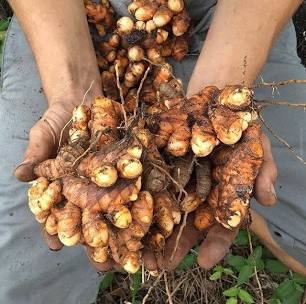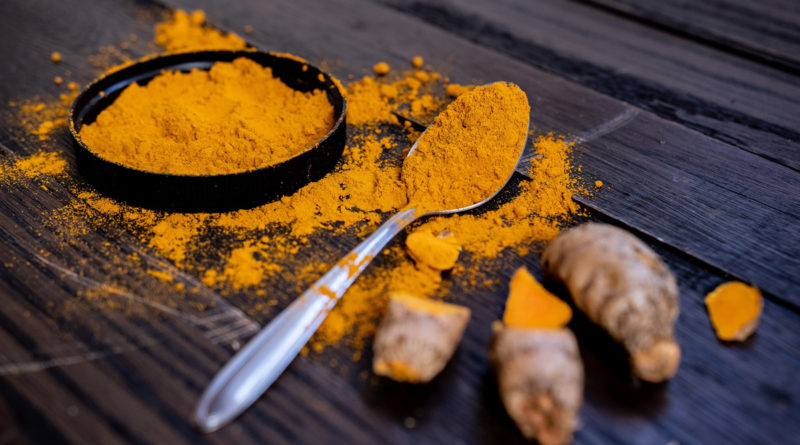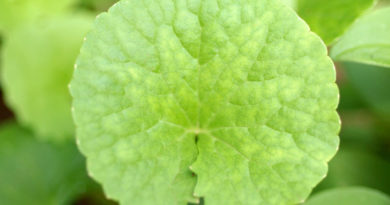8 Benefits of Turmeric
Turmeric
Botanical name: Curcuma longa, Zingiberaceae S: Haridra C: Jiang huang
Part used: rhizome
Energetics:
- Rasa: tikta/bitter, katu/pungent
- Virya: ushna/hot, ruksha/dry
- Vipaka: katu/pungent
- Guna: ruksha/dry, laghu/light
- Dosha: VPK-, PV+ in excess
- Dhatu/Tissues: all
- Srotas/Systems: Mutravaha/Digestive, Raktavaha/Circulatory, Pranavaha/Respiratory, Artavavaha/Female Reproductive
Ayurvedic Action: lekhaniya/scraping, propery dipanapachana/enkindles digestive fire, prameha/useful in diabetes, pandughna/ used in diabetes, pandughna/used in anemia, raktasodhana/ blood purifier, artvajanana/promotes menses, jvaraghna/alleviates fever, krimiaghna/worm destroying, visaghna/ destroys poisins, kandhughna/stops itching, vedanasthapana/analgesic, stanyasodhaka/purifies breasts and milk, raktaprasadana/blood nourisher, varnya/complexion enhancer, kushtaghna/removes skin disease, saindhaniya/heals broken bones. (Srikanthamurthy 2001, 191; Warrier et al 1994, 259)(Pole, 2006)
Starting dosage: 3-5g; up to 10g per day dried root or fresh rhizome tincture, 1:2, 95%, 2-5 ml (Caldecott). 1-10g per day dried root or 3-15ml per day of 1:3 @ 45% tincture. (Pole, 2006)
Constituents: yellow flavonoid constituents: curcuminoids, diarylheptanoids, and methoxylated curcumins. Volatile oils: sesquiterpene ketones such as -tumerone, and volatile compounds including atlantone, zingiberone, -phellandrene, sabinene, cineole and borneol. Glycans: ukonans Other constituents include sugars, proteins, and resins (Mills and Bone 2000, 570; Yoganarasimhan 2000, 171; Kapoor 1990, 149; Evans 1989, 468; Williamson 2002).
Biomedical indications: Poor appetite, dyspepsia, peptic and duodenal ulcers, gas and flatulence, constipation, candidiasis, intestinal parasites, pharyngitis, catarrh, bronchitis, asthma, anemia, cholecystitis, cholecystalgia, jaundice, hepatitis, hepatosplenomegaly, edema, inflammatory joint disease, sports injuries, skin diseases, parasitic skin conditions, wounds, bruises, sprains, fractures, diabetes, dyslipidemia, cardiovascular disease, amenorrhea, gonorrhea, cystitis, cancer prevention and treatment.

Precautions: Do not used concentrated extracts if you have bile obstructions, gallstones, or stomach ulcers.
Safety: The oral LD50 in rats of the petroleum-ether extract of Haridra was determined to be 12.2g/kg (Arora et al 1971). No treatment-related toxicity up to 8 g daily, but that beyond this, the bulky volume of the drug was unacceptable to the patients (Cheng et al 2001). Haridra is commonly used as a culinary spice and is generally recognized as safe. (Caldecott)
Research highlights
Gastrointestinal: One study found that the salt of curcumin inhibited intestinal spasm, and p-tolymethylcarbinol, in Turmeric, increased gastrin, secretin, bicarbonate, and pancreatic enzyme secretion (Ammon and Wahl 1991). Another study demonstrated that increased the barrier of protective mucus and the protein sulfhydryl content in the glandular stomachs of the rats (Rafatulla et al 1990). One clinical study showed that Turmeric given in two capsules, each equal to 300 mg, five times daily had effects on ulceration. In the group with confirmed peptic ulceration, the ulcers were absent in 12 cases after four weeks, that number increasing to 18 after eight weeks, and 19 after 12 weeks of treatment. The abdominal pain and discomfort satisfactorily subsided in all participants within the second week of (Prucksunand et al 2001).
Hepatoprotective: In animal livers exposed to hepatotoxins, including carbon tetrachloride, galactosamine, paracetamol, and Aspergillus aflatoxin (Deshpande et al 1998; Kiso et al. 1983; Donatus et al 1990). In rats subjected to carbon tetrachloride curcumin administration significantly decreased elevated liver enzymes when compared to controls (Park et al. 2000). In ducklings infected with Aspergillus parasiticus, Haridra was shown to inhibit the production of fungal aflatoxin by up to 90 percent. In the same study, both the crude herb as well as curcumin were shown to reverse biliary hyperplasia, fatty changes, and necrosis induced by aflatoxin production, although curcumin alone had no effect on aflatoxin production (Soni et al 1992).
Neuroprotective: Curcumin isolated from Curcuma longa was screened for neuroprotective activity using ethanol as a model of brain injury. The oral administration of curcumin to rats caused a significant reversal in lipid peroxidation, and an enhancement of glutathione, an antioxidant in ethanol-intoxicated rats (Rajakrishnan et al 1999).
Cardiovascular: In a study of experimentally-induced atherosclerosis in rabbits given a dose of a Curcuma extract equal to 1.6-3.2 mg/kg daily, the extract decreased the susceptibility of LDL to undergo lipid peroxidation, and was observed to lower plasma cholesterol and triglyceride levels. Researchers noted that a lower rather than higher dose appeared to be more efficacious (Ramirez-Tortosa et al 1999). The mechanism by which Turmeric lowers cholesterol is thought to be due to decreased cholesterol uptake in the intestines, as well as the increased conversion of cholesterol to bile acids in the liver (Ramprasad and Sirsi 1957). Haridra has also been noted to inhibit of platelet aggregation, thought to be due to its enhancement upon prostacyclin synthesis with a comensurate inhibition of thromboxane synthesis (Srivastava et al 1986).
Antioxidant: An in vitro study measured the effect of curcumin on endothelial heme oxygenase-1, an inducible stress protein, on bovine aortic endothelial cells. Incubation with curcumin resulted in enhanced cellular resistance to oxidative damage (Mortellini et al 2000). In a study of experimental ischemia induced in the feline heart pretreatment with curcumin was found to decrease ischemia-induced changes (Dikshit et al 1995). Both water and fat-soluble extracts of Curcuma and curcumin have exhibited strong antioxidant activities in vitro, comparable to vitamins C and E (Toda et al 1985).
Anti-inflammatory: Low concentrations of curcumin incubated with activated macrophages resulted in a decrease in mRNA levels and nitric oxide synthase activity, down-regulating nitric oxide formation, a process that is now thought to be a key component in inflammation (Brouet and Ohshima 1995). An in vitro preparation of curcumin inhibited lipopolysaccharide-induced production of tumor necrosis factor- and interleukin-1- by a human monocytic macrophage cell line, as well as inhibited lipopolysaccharide-induced activation of nuclear factor kappa B and reduced the biological activity of tumor necrosis factor- in a L929 fibroblast lytic assay (Chan 1995). In an experimental trial using monkeys, curcumin was shown to inhibit neutrophil aggregation associated with inflammation (Srivastava 1989). The oral administration of curcumin in acute experimental inflammation was found to be as effective as cortisone or phenylbutazone, although it was only half as effective in chronic inflammation (Mukhopadhyay et al 1982). In rats with experimentally-induced arthritis the oral administration of Curcuma longa significantly reduced inflammatory swelling compared to controls (Arora et al 1971).
Antitumor: Several animal studies involving rodents as well as in vitro studies on human cell lines have demonstrated curcumin’s ability to inhibit tumor promotion, angiogenesis, and tumor growth (Kawamori et al 1999; Thaloor et al 1998; Limtrakul et al 1997). The results showed that the administration of 0.2% curcumin during both the initiation and postinitiation periods significantly inhibited colon tumorigenesis, and increased apoptosis in the colon tumors as compared to colon tumors in the control groups (Kawamori et al 1999). While the antitumor activities of Haridra and curcumin are due in part to quenching free radicals these, they have also been shown to enhance glutathione levels and inhibit nitrosamine formation, a known carcinogen (Boone et al 1992). Curcumin has demonstrated chemopreventive activities in experimental models of carcinogenesis, inhibiting cyclooxygenase (COX-2), which has been implicated in the development of many human cancers. In one study, researchers noted that curcumin inhibited COX-2 protein induction and prostaglandin E2 production in blood from healthy human volunteers after incubation with lipopolysaccharide (LPS). Researchers further explored this effect in by administering an oral dose of a Curcuma extract in 15 patients with advanced colorectal cancer. An analysis of basal and LPS-induced PGE2 production during treatment demonstrated a trend toward dose-dependent inhibition (Plummer et al 2001). An ethanol extract of Curcuma longa as well as an ointment of curcumin were found to produce remarkable symptomatic relief in patients with external cancerous lesions. Reduction in odour was noted in 90% of the cases and reduction in itching in almost all cases. Dry lesions were observed in 70% of the cases, and a small number of patients (10%) had a reduction in lesion size and pain. In many patients the effect continued for several months. An adverse reaction was noticed in only one of the 62 patients evaluated (Kuttan et al 1987).
Antimicrobial: Chicks infected with the intestinal parasite Eimera maxima and treated with a diet supplemented with one-percent Curcuma longa resulted in a reduction in small intestinal lesion scores and improved weight gain (Allen et al 1998). Guinea pigs infected with dermatophytes and pathogenic fungi were treated topically with a dilution of the volatile oil from Curcuma longa. The oil was found to inhibit the growth of the pathogenic organisms, and within seven days the lesions were observed to disappear completely (Apisariyakul et al 1995).
Chronic anterior uveitis: Curcumin was administered orally to patients suffering from chronic anterior uveitis at a dose of 375 mg three times a day for 12 weeks. The efficacy of curcumin and recurrences following treatment are comparable to corticosteroid therapy, but without any side effects (Lal et al 1999).
Wound healing: The in vivo effects of curcumin on wound healing in rats and guinea pigs was evaluated. Biopsies of the wound showed reepithelialization of the epidermis and increased migration of various cells including myofibroblasts, fibroblasts, and macrophages in the wound bed. Multiple areas within the dermis showed extensive neovascularization and greater collagen deposition. Immunohistochemical localization showed an increase in transforming growth factor--1, which is known to play an important role in wound healing (Sidhu et al 1998). In a similar study performed on the efficacy of curcumin treatment by oral and topical application on impaired wound healing in diabetic rats and genetically diabetic mice, similar beneficial results were obtained (Sidhu et al 1999).
References
Caldecott, Todd, Herbal Profiles on www.toddcaldecott.com
Frawley, Dr. David, Lad, Dr. Vasant, The Yoga of Herbs, 2001 by Lotus Press
Pole, Sebastian, Ayurvedic Medicine, 2006 by Churchill Livingstone
Tillotson, Alan Keith, The One Earth Herbal Sourcebook, 2001 by Kensington Books
Tirtha, Swami Sada Shiva, The Ayurveda Encyclopedia, 1998 Ayurveda Holistic Center Press
Tierra, Michael, Planetary Herbology, 1998 by Lotus Press




